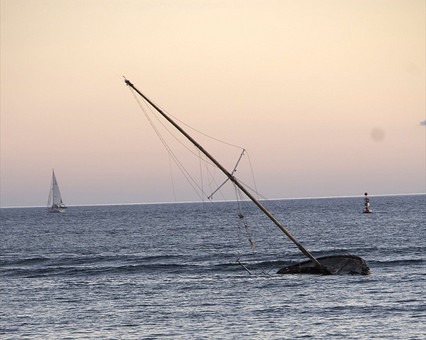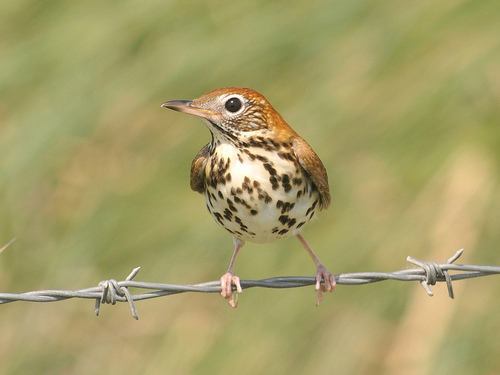
Wood thrush. (Photo by Jeff Whitlock.)
Cross-posted from Cool Green Science.
Mercury pollution — nothing to worry about if I don’t live in the rural Northeast and don’t eat tons of fish, right?
Guess again, says a new report done by the Biodiversity Research Institute (BRI) in conjunction with The Nature Conservancy. The report, “Hidden Risk,” details the widespread and deep impacts of mercury pollution in terrestrial nature — particularly on animals such as songbirds and bats. Researchers are discovering how mercury is causing big declines in reproductive success among these species, as well as physiological oddities — like developmental asymmetries and an inability of some birds to hit high notes.
And the same rain that brings mercury pollution down from the sky falls on us, too. So are these species a kind of canary in the coal mine for mercury’s effects on other vertebrates, including people? And will strict new federal standards limiting U.S. power plant pollution be enough in a world where mercury pollution is on the rise from China and other nations? I talked with two co-authors of “Hidden Risk” — BRI’s executive director, Dave Evers, and Tim Tear, the Conservancy’s director of science for New York — to find out more. (Download the report here.)
Q. Some are going to be surprised that mercury pollution is still a problem — didn’t various agencies and industries take steps to reduce mercury emissions over the last decade in the United States? So why are high levels of mercury still a problem in many wildlife species?
Dave Evers: Yes, a lot of mercury has been taken out of air pollution over the past few decades — but our understanding is growing of how just a little mercury can adversely affect wildlife, and how many species have been affected. More species are being impacted than we had thought, and the toxicity of methylmercury to those species is at lower threshold levels than we ever realized.
Tim Tear: Many of these species and many of the places affected are in people’s backyards. People used to think that mercury pollution was a problem isolated to remote areas of the Northeast. No more.
Q. So, would someone see a bird or a bat acting strangely because of mercury pollution? Or is this something that data is telling you?
Evers: The effects are difficult to see in the field for the average observer. Mercury doesn’t create physical mutations, and an individual animal with mercury will probably die from predation first. But mercury is a neurotoxin that does impact wildlife behavior, and that behavior impacts their survival and reproduction. We focus on data to really quantify the impacts of mercury on the reproductive success of species.
For example, we quantified mercury impacts on the common loon. Common loons need to spend about 98 percent of their time on a nest incubating their eggs to have those eggs successfully hatch. We’ve quantified with over 5,000 hours of observation that loons with high mercury levels spend only 85 percent of their time incubating those eggs. So they spend less time in an incubation posture, and because of that, eggs do not hatch, and because of that, the species’ reproductive success goes down.
Q. Where is the mercury pollution still coming from? And what U.S. regions are of most concern?
Tear: Most of the research has really focused on the Northeast United States — an area that’s been really hard hit by acid rain, which makes mercury a bigger problem. But mercury pollution is happening all over the world. It comes globally from Asia, as well as nationally from power plants in the Midwest, to locally from waste incinerators. We’re going to need to address all sources of mercury to be successful in stopping these impacts.
Q. And in different habitats, right? Most people in the United States who know about mercury in nature know about it through warnings about the fish they eat.
Evers: Yes, there’s been a paradigm shift in new findings. In the past, most of the scientists assessing risk from mercury in an ecosystem would be looking at fish-eating birds and fish-eating mammals — because we knew methylmercury (the organic form of mercury) moved through the food web in aquatic organisms. But there’s been a missing link in looking at mercury in terrestrial ecosystem food webs and looking at how species that eat insects and spiders — what we call “invertivores” — can be affected.
In the invertivore food web, the key pieces are no longer fish, but spiders. A bird that eats a spider that ate a spider that ate a fly — that’s four different changes in the trophic food web. We’ve established that a little songbird like a northern waterthrush or a sparrow that eats spiders can actually be higher up in the food web than a bald eagle, which eats fish — and so that songbird has more mercury in its body than does the eagle.
Tear: We’ve also discovered that mercury is in many more food webs than we realized. It is not just in lakes and ponds. It’s in our forests, our estuaries; it’s in the lowlands and on the mountaintops. It’s in the spiders in the Adirondacks, and it’s in backyard birds in New York City.
Q. You mentioned effects on reproductive success. What are some of the other impacts of mercury on terrestrial wildlife?
Evers: For example, bird song is affected. Two recent studies show that birds with high mercury can’t hit the high notes, and their songs are simplified. I also worry about long-distance migration, because high mercury has been shown to affect the symmetry of development. If a bird’s left wing is 5 percent different in shape than its right wing, that bird is going to fly in a crooked way to compensate for it, which requires more energy to make a flight of thousands of miles to its wintering area. Ultimately, that’s going to affect its survival.
Q. That’s sad. But ultimately, why should humans care?
Tear: First, if you care about the environment and you care about birds and bats and bugs, then you should care that many of these animals are being heavily impacted.
But the second answer is that the neurotoxic rain that contains mercury falls on humans as well as wildlife. We already know that mercury can be a big problem in human health. This research establishes that the effects of mercury are happening all over the planet, all over many habitat types, to vertebrate species other than ourselves. So people should be concerned about these effects, because there’s a link between human health and ecosystem health.
Q. Back to the science of this. How the heck do you measure mercury in a bird population, anyway?
Evers: It’s actually very simple and straightforward. There are nice and easy ways to capture and/or take samples from an individual bird that are quick and are non-harmful to the bird and do very little disruption to its routine, other than just having it in a net or hand for a half hour or so. We take a blood sample — just a drop does the trick. We also can take a feather sample, which gives us more of a long-term picture of how much mercury has come into that individual over time.
Q. But how do you disentangle the effects of mercury on birds and bats from other factors? How do you know that it’s mercury that is causing the decline of the wood thrush or the little brown bat?
Evers: It’s a question we’re still studying. There are multiple stressors at play for many species and habitats, and as conservation biologists, we are trying to understand those. We want to provide scientific information to landscape managers and policymakers, so we will have these birds around for a few more hundred years at least.
Take the olive-sided flycatcher. In the last four years, it’s declined by 80 percent, so 80 percent of this population is gone in comparison to four years ago. It’s a bird that lives in bogs. Bogs are known to have high methylation rates of mercury, but they are not well-studied as a habitat whatsoever. Neither is the olive-sided flycatcher. So here you have a species in a habitat that I think is at great risk to mercury as a potential driver and a primary stressor for why this decline is happening. Mercury is an omnipresent stressor, but the question is always: Where is it a primary stressor?
Tear: I’d also add that, in some places where birds are declining, there has been no obvious habitat change, and many people think of the challenges as being primarily habitat loss, but we certainly know that, for example, some species like the wood thrush within the Adirondack Park, there are fewer wood thrush today than there were 20 years ago. They’re still there, but there aren’t as many. The question is why, and this is part of the disentangling of those different stressors that Dave is referring to.
Q. Is there any relationship between mercury emissions and greenhouse-gas emissions? Is there a climate change connection?
Tear: Well, many of the greenhouse gases like carbon dioxides and other air pollutants — such as nitrogen and sulfur, which cause acid rain, and mercury, which brings us this neurotoxic rain — come from power plants, and all of these air pollutants have negative impacts on our environment. Our research shows that we should be factoring in these ecological impacts when we consider the cost and benefits of regulatory programs such as the recent Mercury and Air Toxics Standards Rule. But so far, estimating the ecological impact of these air pollutants that are coming from similar sources as CO2 has not been done.
Evers: Climate change might also be causing great mercury methylation rates into ecosystems or even remobilizing mercury that was stored in the system. For instance, forest fires have become more predominant because of climate change in some parts of the country — and those forests hold a lot of legacy mercury in their systems, which can be released quite rapidly with a fire. Greater storm intensity and frequency could be increasing deposition of mercury from the global atmospheric pool to landscapes below. Increased wetting and drying cycles could be another factor in greater mercury methylation.
Q. It sounds dire. So what can anyone do?
Tear: First, while we need more research on this, there are definitely landscape and wildlife management actions that might help reduce the amount of mercury embedded in the environment.
Dave mentioned that hotter forest fires that occur for whatever reason can release a great deal more mercury than cooler burns — so using fire management in our forest systems could have a significant impact on the amount of mercury that’s released. How we manage artificial reservoirs is extremely important — if we manage those in a way to make the wetting and drying cycles greater, we might also be increasing the amount of mercury methylation.
Evers: Another example: It makes a lot of sense not to log in a riparian area anyway — and it also makes sense from a mercury standpoint. There is a lot of legacy mercury and even new mercury coming into these forest ecosystems, and the less we disturb that mercury the better. There are studies right now quantifying the mercury effects of logging practices in Oregon.
Q. What else?
Tear: We need greater investment in this country’s mercury monitoring network. A stronger network would help us gather data systematically and also help us know whether current efforts to reduce mercury pollution — like the EPA’s recent Mercury and Air Toxics Rule standard — are enough to improve these areas already damaged by mercury.
We also need continued research on this issue. We’re just beginning to understand the impacts of mercury on both ecological and human health. And we need to support efforts at all levels to reduce mercury — global, regional, and local. Mercury is coming from multiple levels, and no single level will be enough.
Evers: On the importance of a national network — I’ve been fortunate to work with both U.S. Senate and House representatives to introduce bills that would establish the first national mercury monitoring network, which we need from a federal accountability standpoint. But industry also has been supportive of this idea. Industry likes certainty, and a national monitoring network could really help provide a standard playing field for the industry in terms of installing emission protections on their smokestacks.
And a national monitoring network could also help the United States politically wrangle with other countries where mercury emissions are increasing. About 50 percent of mercury emissions have been taken out of U.S. sources between 1990 and 2005 — but the global pool of mercury continues to increase because countries like China are putting in a new coal-fired power plant once a week. A standardized mercury monitoring program provides us the way to really track our progress both spatially and temporally.



